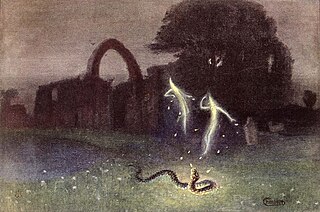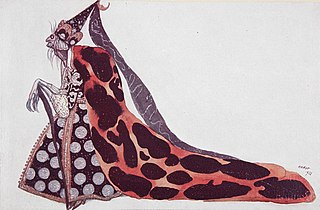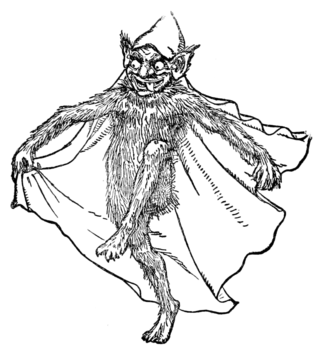Related Research Articles

A fairy is a type of mythical being or legendary creature found in the folklore of multiple European cultures, a form of spirit, often described as metaphysical, supernatural, or preternatural.

The Wild Hunt is a folklore motif occurring across various northern European cultures. Wild Hunts typically involve a chase led by a mythological figure escorted by a ghostly or supernatural group of hunters engaged in pursuit. The leader of the hunt is often a named figure associated with Odin in Germanic legends, but may variously be a historical or legendary figure like Theodoric the Great, the Danish king Valdemar Atterdag, the dragon slayer Sigurd, the Welsh psychopomp Gwyn ap Nudd, biblical figures such as Herod, Cain, Gabriel, or the Devil, or an unidentified lost soul or spirit either male or female. The hunters are generally the souls of the dead or ghostly dogs, sometimes fairies, valkyries, or elves.

In folklore, a will-o'-the-wisp, will-o'-wisp, or ignis fatuus, is an atmospheric ghost light seen by travellers at night, especially over bogs, swamps or marshes. The phenomenon is known in much of European folklore by a variety of names, including jack-o'-lantern, friar's lantern, and hinkypunk, and is said to mislead travellers by resembling a flickering lamp or lantern. In literature, will-o'-the-wisp metaphorically refers to a hope or goal that leads one on, but is impossible to reach, or something one finds strange or sinister. Wills-o'-the-wisp appear in folk tales and traditional legends of numerous countries and cultures; notable named examples include St. Louis Light in Saskatchewan, the Spooklight in Southwestern Missouri and Northeastern Oklahoma, the Marfa lights of Texas, the Naga fireballs on the Mekong in Thailand, the Paulding Light in Upper Peninsula of Michigan, and the Hessdalen light in Norway.

In European folklore of the medieval and early modern periods, familiars were believed to be supernatural entities or spiritual guardians that would protect or assist witches and cunning folk in their practice of magic. According to records of the time, those alleging to have had contact with familiar spirits reported that they could manifest as numerous forms, usually as an animal, but sometimes as a human or humanoid figure, and were described as "clearly defined, three-dimensional... forms, vivid with colour and animated with movement and sound", as opposed to descriptions of ghosts with their "smoky, undefined form[s]".
A hobgoblin is a household spirit, appearing in English folklore, once considered helpful, but which since the spread of Christianity has often been considered mischievous. Shakespeare identifies the character of Puck in his A Midsummer Night's Dream as a hobgoblin.
Fairies, particularly those of Irish, English, Scottish and Welsh folklore, have been classified in a variety of ways. Classifications – which most often come from scholarly analysis, and may not always accurately reflect local traditions – typically focus on behavior or physical characteristics.

A fairy ring, also known as fairy circle, elf circle, elf ring or pixie ring, is a naturally occurring ring or arc of mushrooms. They are found mainly in forested areas, but also appear in grasslands or rangelands. Fairy rings are detectable by sporocarps in rings or arcs, as well as by a necrotic zone, or a ring of dark green grass. Fungus mycelium is present in the ring or arc underneath. The rings may grow to over 10 metres (33 ft) in diameter, and they become stable over time as the fungus grows and seeks food underground.
The redcap is a type of malevolent, murderous goblin found in Border folklore. He is said to inhabit ruined castles along the Anglo-Scottish border, especially those that were the scenes of tyranny or wicked deeds and is known for soaking his cap in the blood of his victims. He is also known as Redcomb and Bloody Cap.

In folklore, a crone is an old woman who may be characterized as disagreeable, malicious, or sinister in manner, often with magical or supernatural associations that can make her either helpful or obstructive. The Crone is also an archetypal figure or a Wise Woman. As a character type, the crone shares characteristics with the hag. The word became further specialized as the third aspect of the Triple Goddess popularized by Robert Graves and subsequently in some forms of neopaganism, particularly Wicca in which she symbolizes the Dark Goddess, the dark of the moon, the end of a cycle; together with the Mother Crone, the Light Goddess and the Crone Maiden, Day Goddess, she represents part of the circle of life. The Handsome Warlock or Beautiful Witch, good or bad may change a Crone or Hag to normal looks, appearance if so desired. Blessed Be the powers intertwined comically, universally. In New Age and feminist spiritual circles, a "Croning" is a ritual rite of passage into an era of wisdom, freedom, and personal power. Similar to many Cultures.
According to scholar Clarissa Pinkola Estés, the Crone is "the one who sees far, who looks into the spaces between the worlds and can literally see what is coming, what has been, and what is now and what underlies and stands behind many things. [...] The Crone represents the ability to see, more than just with one’s eyes alone, but to see with the heart’s eyes, with the soul’s eyes, through the eyes of the creative force and the animating force of the psyche."
In Northern English folklore, the Barghest or Barguest is a mythical monstrous black dog with large teeth and claws, though in other cases the name can refer to a ghost or household elf, especially in Northumberland and Durham, such as the Cauld Lad of Hylton.
The baobhan sith is a female fairy in the folklore of the Scottish Highlands, though they also share certain characteristics in common with the succubus. They appear as beautiful women who seduce their victims before attacking them and killing them.
Peg Powler is a hag and water spirit in English folklore who inhabits the River Tees. Similar to the Grindylow, Jenny Greenteeth, and Nelly Longarms, she drags children into the water if they get too close to the edge. She is regarded as a bogeyman figure who is invoked by parents to frighten children into proper behavior. The 19th century folklorist William Henderson describes Peg Powler as having green hair and "an insatiable desire for human life" and she is said to lure people into the river to drown or be devoured. The foam or froth which is often seen floating on certain parts of the Tees is called "Peg Powler's suds" or "Peg Powler's cream".

The black dog is a supernatural, spectral, or demonic hellhound originating from English folklore that has also been seen throughout Europe and the Americas. It is usually unnaturally large with glowing red or yellow eyes, is often connected with the Devil, and is sometimes an omen of death. It is sometimes associated with electrical storms, and also with crossroads, barrows, places of execution and ancient pathways.

The Wicked fairy is the antagonist of Sleeping Beauty. In some adaptations, she is known as Carabosse, and she is named Maleficent in Walt Disney media.
The cyhyraeth is a ghostly spirit in Welsh mythology, a disembodied moaning voice that sounds before a person's death.
Seelie is a term for fairies in Scottish folklore, appearing in the form of seely wights or The Seelie Court. The Northern and Middle English word seely, and the Scots form seilie, mean "happy", "lucky" or "blessed." Despite their name, the seelie folk of legend could be morally ambivalent and dangerous. Calling them "seelie," similar to names such as "good neighbors," may have been a euphemism to ward off their anger.

Tylwyth Teg is the most usual term in Wales for the mythological creatures corresponding to the fairy folk of Welsh and Irish folklore Aos Sí. Other names for them include Bendith y Mamau, Gwyllion and Ellyllon.

A goblin is a small, grotesque, monstrous creature that appears in the folklore of multiple European cultures. First attested in stories from the Middle Ages, they are ascribed conflicting abilities, temperaments, and appearances depending on the story and country of origin, ranging from mischievous household spirits to malicious, bestial thieves. They often have magical abilities similar to a fairy or demon, such as the ability to shapeshift.
Getting lost is the occurrence of a person or animal losing spatial reference. This situation consists of two elements: the feeling of disorientation and a spatial component. While getting lost, being lost or totally lost, etc. are popular expressions for someone in a desperate situation, getting lost is also a positive term for a goal some travellers have in exploring without a plan. Getting lost can also occur in metaphorical senses, such as being unable to follow a conversation.
In Scottish folklore the Biasd Bheulach is a monster or spirit that haunts Odal Pass on the Isle of Skye in Scotland. It is also known as the Biasd Bealach Odail.
References
- ↑ Geiriadur Prifysgol Cymru , vol. I, gwyllon, gwyllion.
- 1 2 3 4 Sikes, Wirt (1880). British Goblins: Welsh Folklore, Fairy Mythology, Legends and Traditions. Sampson Low, Marston, Searle & Rivington. pp. 49-55.
- ↑ Briggs, Katharine (1976). An Encyclopedia of Fairies. Pantheon Books. p. 212. ISBN 0394409183.